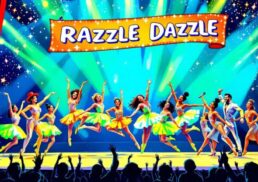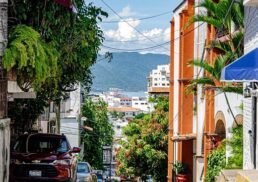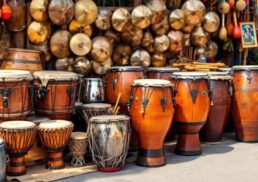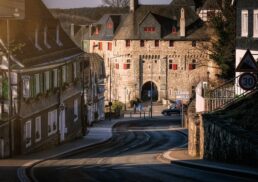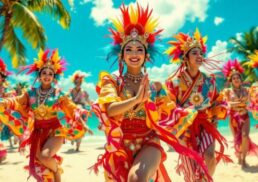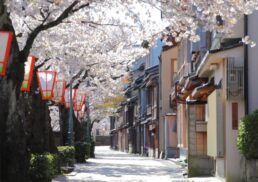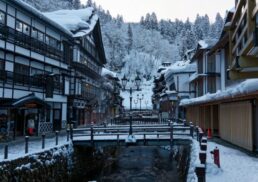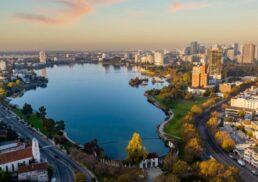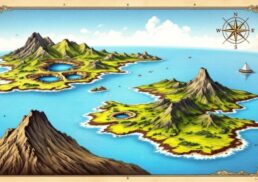Minneapolis, affectionately known as the ‘mini apple’, and Saint Paul, often referred to as the Twin Cities, are rich in history, culture, and modern conveniences. This comprehensive guide will provide you with essential information on their historical roots, economic drivers, cultural landmarks, educational institutions, and what it’s like to live or visit these vibrant cities, collectively known as Minneapolis Saint Paul.
Table of Contents
Key Takeaways
The Twin Cities, Minneapolis and Saint Paul, have evolved from early settlement near waterways to a major economic hub with a diversified economy, shaping their unique identities.
A vibrant arts and culture scene characterizes the Twin Cities, supported by renowned performing arts venues, museums, and annual festivals that reflect the region’s diverse heritage.
Educational institutions, including major universities and community colleges, play a pivotal role in driving economic growth, providing workforce development, and enhancing the quality of life in the Twin Cities.
Origins and Development of the Twin Cities
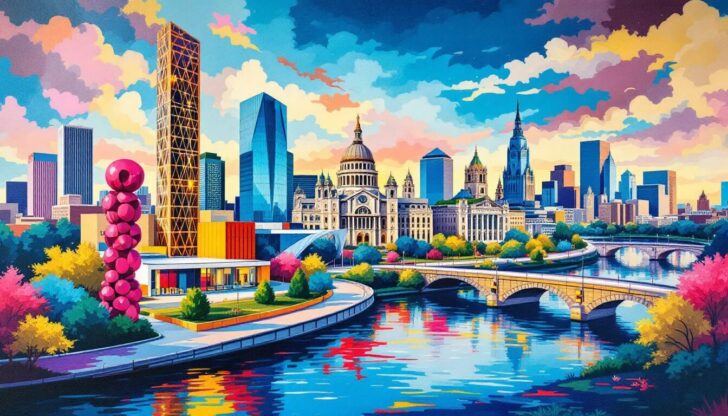
The Twin Cities’ origins are deeply connected to the region’s natural landscape and waterways. The Mississippi, Minnesota, and St. Croix rivers were instrumental in the early settlement and growth of Minneapolis and Saint Paul. European settlers initially established themselves near Stillwater, setting the stage for the bustling metropolitan area we know today.
Minneapolis, with its mix of historic and contemporary architecture, showcases a city that has significantly evolved since the late 1800s. These elements have collectively shaped the identity and development of the Twin Cities.
Early Settlement
The founding of Fort Snelling marked the early settlement of the Twin Cities, establishing a European presence in the region. The original villages that eventually became Saint Paul were Pig’s Eye and Lambert’s Landing, highlighting the humble beginnings of what would grow into a significant urban center. The Mississippi River Valley profoundly influenced early communities by providing essential resources and transportation routes.
As settlers moved westward, the strategic location along the Mississippi River attracted trade and settlement. The river’s presence not only supported the local economy but also shaped the cultural and social dynamics of the region.
This period set the stage for the economic and architectural growth that would develop Minneapolis and Saint Paul into major Upper Midwest cities.
Economic Evolution
The economic evolution of the Twin Cities demonstrates their resilience and adaptability. During the 19th and 20th centuries, Minneapolis and Saint Paul shifted from an agrarian economy to one focused on manufacturing and services. Milling and timber industries along the Mississippi River were significant in this transformation, setting the stage for further industrial development and urbanization. These industries laid the foundation for a robust economy that diversified and expanded over time.
Compared to the national average, the cost of living in the Twin Cities is relatively moderate, making it an attractive place for both businesses and residents.
Today, healthcare, finance, and technology define the economic landscape of the Twin Cities. Major employers like U.S. Bancorp, Allina Health, and Target Corporation drive local economic activity and offer numerous job opportunities for residents. The growth of these industries has bolstered the local economy and positioned the Twin Cities as a leading regional economic hub.
Historical Landmarks
The rich history of Minneapolis is closely linked to its milling and timber industries, which played a crucial role in the city’s growth and development. The Stone Arch Bridge, one of Minneapolis’s iconic landmarks, offers stunning views of the Mississippi River and the city skyline. This historic bridge stands as a testament to the city’s industrial heritage and is a popular destination for both locals and visitors.
Saint Paul, known for its historic architecture, is the state capital of Minnesota and rich in historical significance. Landmarks like the Cathedral of Saint Paul, an exquisite example of Beaux-Arts architecture, and the Landmark Center, a cultural hub showcasing the city’s history, exemplify Saint Paul’s rich architectural heritage.
These landmarks reflect the city’s historical narrative and contribute to its unique charm and identity.
Socioeconomic Landscape
The socioeconomic landscape of the Twin Cities is a vibrant tapestry, blending urban and suburban living. Minneapolis and Saint Paul, central to Minnesota’s economy and culture, are home to a diverse population that enriches the region’s cultural fabric.
Numerous educational institutions enhance the local economy and community, providing a foundation for growth and development. This diversity and blend of socioeconomic factors create a unique environment that sets the Twin Cities apart.
Population and Demographics
The Twin Cities, comprising Minneapolis and Saint Paul, have a population of approximately 716,000 residents. This metropolitan area is a significant hub in Minnesota, with nearly two-thirds of the state’s population residing within its boundaries. The region’s demographic composition is influenced by its early inhabitants, including the Ojibwe and Dakota people, and diverse European settlers who introduced Scandinavian, Lutheran, French, Irish, and German Catholic cultures.
Hennepin County, home to Minneapolis, has the largest population within the Twin Cities with 1,268,903 residents, followed by Ramsey County, which includes Saint Paul, with 544,438 residents. Counties like Dakota, Washington, and Anoka also significantly contribute to the metropolitan area’s population.
This diverse demographic mix enriches the cultural landscape of the Twin Cities, creating a vibrant and inclusive region.
Economic Drivers
The economic drivers of the Twin Cities have significantly evolved over the years. Initially, Minneapolis developed as a milling hub due to the water power provided by the falls on the Mississippi River. Saint Paul’s economy was bolstered by its role as a shipping and transportation center. Over time, the region transitioned from heavy industry to a diversified economy that includes healthcare, finance, and technology.
When comparing economic significance, the Twin Cities are often mentioned alongside San Francisco, one of the largest banking centers in the U.S. This comparison highlights the importance of both regions in the financial sector.
Educational institutions, particularly the University of Minnesota, play a key role in driving economic growth in the Twin Cities. The university has launched over 260 startups in the last two decades, significantly contributing to the local economy. In FY2022, educational institutions in the Twin Cities generated $8.4 billion in economic impact, supporting over 62,000 jobs in the state.
This strong educational foundation fosters innovation and attracts businesses, further enhancing regional economic development.
Social Issues and Movements
In recent years, the Twin Cities have been at the forefront of social issues and movements. The 2020 protests highlighted the urgent need to address racial inequality and police reform in the metropolitan area. These events brought national attention to the region and spurred discussions and actions toward creating a more equitable society. The construction of highways in the Twin Cities has significantly shaped urban planning, often affecting neighborhoods with higher populations of people of color.
The impact of highway construction on land use in the Twin Cities cannot be understated. Highways have contributed to urban displacement and the loss of community spaces, altering the region’s social fabric. These developments underscore the need for thoughtful urban planning and addressing historical injustices to create a more inclusive and connected community.
Arts and Culture in the Twin Cities
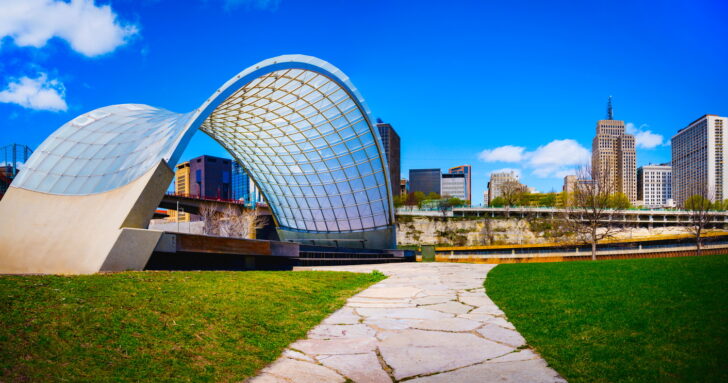
The Twin Cities have a vibrant arts and culture scene that is both diverse and dynamic. From street art and murals to world-class theaters and galleries, Minneapolis st and Saint Paul are cultural epicenters in the Upper Midwest.
The rich demographic composition, including a growing number of immigrants, contributes to the cultural diversity, making the Twin Cities a melting pot of artistic expressions.
Performing Arts Venues
Several renowned venues anchor the performing arts scene in the Twin Cities. The Guthrie Theater, overlooking the Mississippi River, is a world-class regional theater known for its innovative productions and striking architecture. The Orpheum Theatre in downtown Minneapolis hosts major touring Broadway productions and concerts, while the Ordway Center for the Performing Arts in Saint Paul offers a range of performances including Broadway shows and concerts.
The State Theatre is another prominent location for performances and cultural events, highlighting its significance in Minneapolis’s vibrant entertainment scene.
First Avenue in Minneapolis is a legendary music venue that has hosted both emerging and established artists across various genres, cementing the city’s reputation as a music hub. Notable venues include the Brave New Workshop Comedy Theater and the artistic districts of Lowertown and Northeast Minneapolis, which feature galleries, theaters, and vibrant dining options.
Museums and Galleries
The Twin Cities are home to several notable museums and galleries that showcase diverse artistic expressions. The Walker Art Center is a leading contemporary art museum known for its innovative exhibitions and emphasis on visual and performing arts. The Minneapolis Institute of Art offers an extensive collection of artworks spanning various cultures and historical periods, making it a must-visit for art enthusiasts.
Other significant museums include the Frederick R. Weisman Art Museum, known for its modern architecture and contemporary collections, and the Mill City Museum, which delves into the region’s milling history with interactive exhibits. These institutions preserve the artistic heritage of the Twin Cities and contribute to the vibrant cultural landscape.
Annual Festivals
The Twin Cities host various annual festivals that celebrate the region’s cultural and artistic heritage. The Saint Paul Winter Carnival is a beloved event that embraces winter with parades, ice sculptures, and various activities, drawing visitors from across the region. In the summer, Minneapolis comes alive with the Aquatennial, featuring parades, fireworks, and family-friendly activities.
Music lovers eagerly anticipate the Twin Cities Jazz Festival, showcasing local and national jazz musicians in performances across the cities. These festivals, along with other cultural events, highlight the vibrant arts scene and provide opportunities for residents and visitors to immerse themselves in the diverse artistic expressions of the Twin Cities.
Education and Research Institutions
Education plays a pivotal role in the Twin Cities, with diverse institutions shaping the region’s educational and economic landscape. From research universities to community colleges and technical schools, the Twin Cities offer a wealth of educational opportunities that cater to diverse learning needs and contribute significantly to the local economy.
Major Universities
The University of Minnesota is a prominent research university that ranks among the top 20 in the United States, known for its comprehensive educational offerings and significant research contributions. With an enrollment exceeding 70,000 students, the university plays a crucial role in advancing education and innovation in the region.
Other notable institutions include Hamline University, Minnesota’s first university, which offers a variety of innovative programs addressing modern societal needs. These universities not only provide high-quality education but also enhance the local job markets and stimulate economic growth through research initiatives and workforce development.
Their presence attracts businesses and fosters a culture of innovation, making the Twin Cities a hub for academic excellence and economic vitality.
Community Colleges and Technical Schools
Community colleges and technical schools in the Twin Cities play a crucial role in providing accessible education and vocational training to the local population. Century College, formed by merging two institutions, offers over 60 technical and occupational programs while also focusing on liberal arts education. Minneapolis College provides a range of affordable programs, including degrees and certificates, catering to diverse educational pathways.
These institutions significantly contribute to the educational landscape by equipping students with practical skills and flexible learning opportunities. They play an essential role in meeting the demands of the local workforce and supporting the economic development of the region.
Economic Impact of Education
The economic impact of educational institutions in the Twin Cities is substantial. The University of Minnesota alone brings in over $1.35 billion in research expenditures, highlighting its significant contribution to the local economy. Higher education institutions enhance local job markets and stimulate economic growth through research initiatives and workforce development.
Educational institutions in the Twin Cities also offer job training programs that align with local workforce demands, further supporting economic development. These programs ensure that graduates are well-prepared to meet the needs of the local economy, contributing to the region’s overall prosperity.
Architectural Highlights
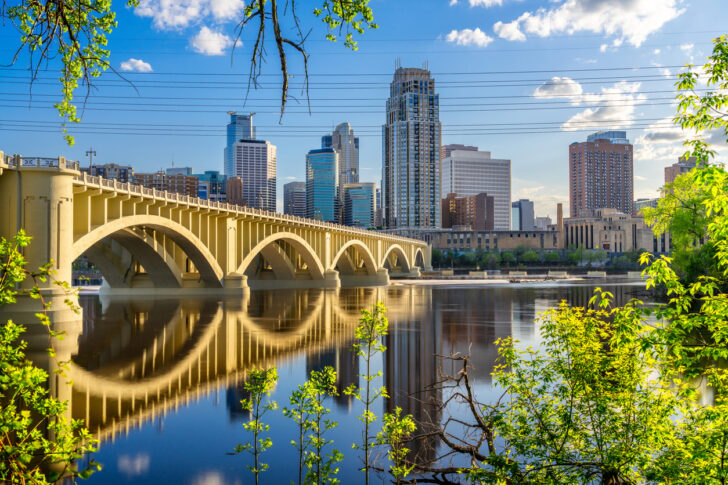
The architectural landscape of the Twin Cities is a fascinating blend of modernist skyscrapers and historic buildings. From the towering IDS Center in Minneapolis to the stunning Neoclassical designs in Saint Paul, the architecture of the Twin Cities reflects their rich history and dynamic growth.
Landmarks like the Stone Arch Bridge and Fort Snelling further reveal the historical significance and cultural identity of the region.
Skyscrapers and Modern Designs
Minneapolis is known for its impressive skyline, dominated by the IDS Center, the tallest building in the city, standing at 792 feet. The IDS Center’s modern glass facade is a striking feature of the Minneapolis skyline, reflecting the city’s contemporary architectural style. Prominent architectural styles in Minneapolis include Richardson Romanesque, Art Deco, and modern glass facades, showcasing the city’s diverse architectural heritage.
These modern designs not only enhance the city’s aesthetic appeal but also represent its economic growth and development. The blend of historic and contemporary architecture in Minneapolis creates a unique urban landscape that is both visually stunning and culturally rich.
Historic Structures
Saint Paul is home to several notable historic structures that reflect its rich architectural heritage. The Landmark Center, originally functioning as a federal court and post office, is a prime example of historic architecture in the city. The Turnblad Mansion, built between 1904 and 1908, showcases French Renaissance architectural features and is a key historic site in Saint Paul.
Another significant historic structure is the Lumber Exchange Building in Minneapolis, recognized as one of the oldest commercial skyscrapers west of New York City. These historic buildings not only preserve the architectural history of the Twin Cities but also contribute to their cultural identity and charm.
Notable Landmarks
The Twin Cities area are home to several notable landmarks that showcase their cultural and architectural heritage.
The National Climatic Data Center provides historical climate records and significant temperature extremes for the Minneapolis–Saint Paul metropolitan area, emphasizing the region’s severe and variable climate.
Some of these landmarks include:
The Basilica of St. Mary, completed in 1926, celebrated for its Neoclassical Beaux-Arts architecture and stunning stained glass.
The Minnesota State Capitol, which reflects the rich history and cultural significance of the region.
The Stone Arch Bridge, known for its historical importance and beautiful design.
These landmarks collectively highlight the rich history and cultural significance of the region.
These landmarks not only serve as architectural marvels but also as symbols of the Twin Cities’ historical and cultural legacy. They attract visitors from around the world and provide residents with a deep sense of pride and connection to their city’s past.
Recreational Activities and Natural Beauty
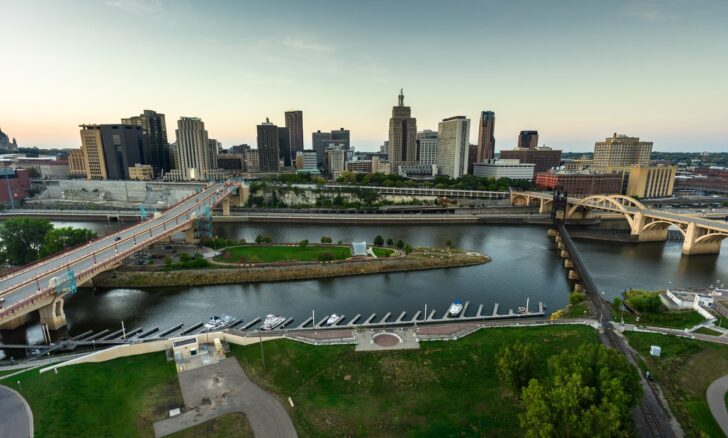
The Twin Cities offer a wealth of recreational activities and natural beauty, making them an ideal destination for outdoor enthusiasts. From the numerous parks and lakes to the extensive trail systems, Minneapolis and Saint Paul provide a variety of opportunities for residents and visitors to enjoy the great outdoors.
The natural beauty of the region enhances the quality of life and creates a serene backdrop for urban living.
Parks and Lakes
Minneapolis is home to a vast network of parks, ensuring that residents are never more than six blocks away from a park. Popular spots like Minnehaha Park, famous for its stunning waterfall, and Lyndale Park, known for its beautiful gardens, offer scenic locations for picnicking and outdoor concerts during the summer months. The city also boasts over 22 lakes, providing ample opportunities for water activities like kayaking and paddleboarding.
Lake Phalen in Saint Paul is another popular recreational area, featuring a scenic bike path and beach access. The Midtown Greenway, a popular urban trail in Minneapolis, provides a safe route for cyclists and walkers, further enhancing the city’s appeal to outdoor enthusiasts.
Trails and Green Spaces
The Twin Cities are renowned for their extensive trail systems and green spaces. The Grand Rounds Scenic Byway offers a network of trails that connect parks and lakes across Minneapolis, providing stunning views and a variety of recreational opportunities. The Midtown Greenway, another notable urban trail, provides a safe and scenic route for biking and walking through the city.
The Mississippi Gorge Loop Trail is a favorite among locals, offering breathtaking river views and a mix of paved and unpaved paths. These trails and green spaces not only enhance the outdoor experience but also promote a healthy and active lifestyle, making the Twin Cities a prime location for nature lovers and outdoor adventurers.
Seasonal Events
The Twin Cities come alive with a variety of seasonal events that celebrate the region’s unique character and outdoor beauty. From summer festivals that highlight local culture and music to winter sports competitions that embrace the colder months, there is always something happening in Minneapolis and Saint Paul.
These events provide residents and visitors with numerous opportunities to engage with the community and enjoy the changing seasons.
Downtown Minneapolis Attractions
Downtown Minneapolis is a vibrant and bustling area filled with a variety of attractions that cater to different interests. One of the most popular attractions is the Mill City Museum, located in the ruins of the Washburn A Mill, a National Historic Landmark. This museum offers a fascinating glimpse into the history of Minneapolis and the flour milling industry that once dominated the city. Visitors can explore interactive exhibits, watch multimedia shows, and even take in stunning views of the Mississippi River from the museum’s observation deck.
Art enthusiasts will find the Walker Art Center a must-visit destination. This contemporary art museum features a diverse collection of modern and contemporary art, including works by renowned artists such as Andy Warhol and Jasper Johns. The center also hosts various performances and events throughout the year, including dance, theater, and music, making it a cultural hub in downtown Minneapolis.
For sports enthusiasts, U.S. Bank Stadium is a state-of-the-art facility that serves as the home of the Minnesota Vikings football team. The stadium offers guided tours that provide an insider’s look at the field, the Vikings’ locker room, and other exclusive areas. It’s a must-see for any football fan visiting the Twin Cities.
Other notable attractions in downtown Minneapolis include the Minneapolis Sculpture Garden, which features over 50 modern and contemporary sculptures, including the iconic Spoonbridge and Cherry sculpture. The area is also home to a variety of restaurants, bars, and clubs, including the legendary First Avenue nightclub, which has hosted some of the biggest names in music and continues to be a cornerstone of the city’s vibrant nightlife.
Learn more, checkout A Guide Minneapolis’ Downtown Central District.
Saint Paul: A City with a Unique Character
Saint Paul, the capital city of Minnesota, boasts a unique character that sets it apart from its twin city, Minneapolis. With a rich history dating back to the 19th century, Saint Paul is home to many historic landmarks that reflect its storied past. The Minnesota State Capitol building, with its stunning Beaux-Arts architecture, and the majestic Cathedral of Saint Paul are two of the city’s most iconic structures, offering visitors a glimpse into the city’s architectural heritage.
The city’s vibrant arts and cultural scene is another defining feature. The Ordway Center for the Performing Arts is a premier venue that hosts a variety of performances, including theater, dance, and music. Whether you’re a fan of Broadway shows or classical concerts, the Ordway offers a diverse lineup that caters to all tastes.
Saint Paul is also renowned for its festivals, which celebrate the city’s unique culture and community spirit. The Winter Carnival, held every January, is a beloved tradition that features ice sculptures, snow sculptures, and a variety of winter activities. It’s a festive event that draws visitors from across the region and showcases the city’s ability to embrace the colder months with enthusiasm.
Sports fans can catch a game at CHS Field, home to the Saint Paul Saints baseball team. This modern ballpark offers a fun and family-friendly atmosphere, making it a great place to enjoy America’s favorite pastime.
Local Cuisine and Craft Beer
The Twin Cities are a haven for food and drink enthusiasts, offering a vibrant culinary scene and a thriving craft beer culture. One of the most iconic local dishes is the Juicy Lucy, a burger filled with melted cheese that is said to have originated in Minneapolis. This delicious creation can be found at various eateries throughout the city, each offering their unique twist on the classic.
The craft beer scene in the Twin Cities is equally impressive, with numerous breweries producing a wide range of beer styles. Surly Brewing Co., Fulton Beer, and Indeed Brewing Company are just a few of the popular breweries that have made a name for themselves in the area. These breweries often feature taprooms where visitors can sample their latest creations, enjoy live music, and indulge in food from local food trucks.
In addition to craft beer, the Twin Cities are known for their coffee culture. Independent coffee shops like Spyhouse Coffee, Dunn Brothers Coffee, and Caribou Coffee offer a cozy atmosphere and expertly brewed coffee, making them popular spots for both locals and visitors to relax and recharge.
Transportation and Connectivity
Transportation and connectivity are crucial aspects of life in the Twin Cities, ensuring that residents and visitors can easily navigate the metropolitan area. Minneapolis and Saint Paul are served by a robust public transit system, including Metro Transit buses and light rail services, which provide convenient connections to key destinations across the cities.
The comprehensive road networks further enhance accessibility and support both personal and commercial transportation needs.
Public Transit Systems
The Minneapolis Metro Transit system operates light rail and bus services, offering comprehensive public transportation options across the metropolitan area. The light rail system consists of two main lines: the Blue Line and the Green Line, which connect key areas and suburbs, making it easy for residents and visitors to travel within the Twin Cities. The Northstar Commuter Rail further enhances regional transit options by connecting the Twin Cities with the northern suburbs.
Looking ahead, the METRO Gold Line is set to launch in March 2025, becoming Minnesota’s first bus rapid transit line operating mainly in dedicated bus lanes. This new line will connect key areas like Saint Paul, Maplewood, and Oakdale, improving regional mobility along the I-94 corridor and providing an efficient and reliable transit option for commuters.
Road Networks and Highways
The road networks and highways in the Twin Cities play a vital role in facilitating travel across the region. Major highways such as I-94, I-35E, I-35W, I-494, and I-694 provide crucial links between various neighborhoods, suburbs, and key destinations. These highways ensure that residents and visitors can easily access downtown Minneapolis and other important areas, supporting both personal and commercial transportation needs.
The extensive road network also includes routes like I-394, which provides direct access to downtown Minneapolis, further enhancing connectivity. This well-planned infrastructure supports economic growth and ensures that the Twin Cities remain accessible and connected.
Future Developments
Future transportation developments in the Twin Cities aim to enhance connectivity and improve accessibility for residents and visitors. Upcoming projects include the extension of the light rail system to better serve surrounding communities and improve transit options. The Gold Line extension, set to be completed by 2027, will feature new transit stations along I-94, enhancing access to downtown Minneapolis and other key areas.
Plans for future transportation improvements also include expanding public transit options and rethinking existing roadways to better serve communities. These developments will ensure that the Twin Cities continue to grow and evolve, providing efficient and reliable transportation options for all.
Living in the Twin Cities
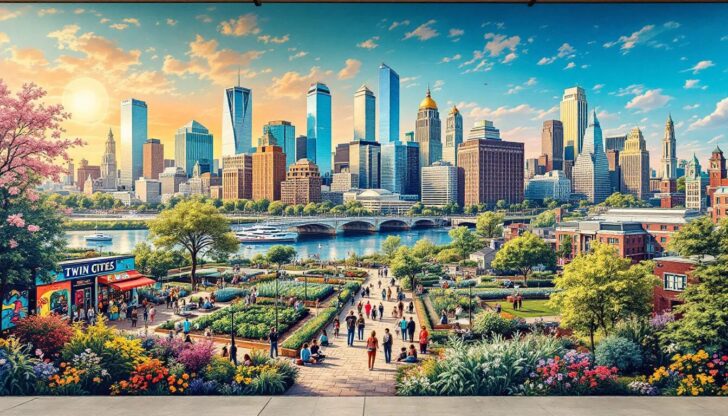
Living in the Twin Cities offers a diverse and enriching experience, with a variety of neighborhoods, housing options, and lifestyle amenities to suit different preferences. From the bustling streets of downtown Minneapolis to the serene suburbs of Saint Paul, the Twin Cities provide a unique blend of urban and suburban living that caters to a wide range of residents.
Neighborhood Profiles
The neighborhoods in Minneapolis and Saint Paul each have their distinct character and charm. The Whittier neighborhood in Minneapolis offers affordable rental options that cater to young professionals and recent graduates. Uptown is another popular area for recent graduates, known for its vibrant urban lifestyle and community amenities.
In Saint Paul, the Cathedral Hill neighborhood is characterized by its historic architecture and proximity to the notable Cathedral of Saint Paul. Highland Park in Saint Paul offers a family-friendly atmosphere with parks and schools, making it a desirable area for residents.
These diverse neighborhoods reflect the unique cultural fabric of Minneapolis Saint Paul, blending affordability, history, and community to create a rich and varied living experience.
Housing Market
The Twin Cities housing market has seen a steady increase in home prices, offering a range of options for buyers. The average rent for a one-bedroom apartment in Minneapolis is about $1,418, reflecting the growing demand for rental properties in the area. Popular neighborhoods have seen a notable increase in rental prices as more people seek to live in these vibrant communities.
There are also various assistance programs available for first-time homebuyers in the Minneapolis-Saint Paul metro area, helping residents achieve their dreams of homeownership. These programs provide valuable support and resources, making it easier for individuals and families to navigate the housing market and find their ideal home.
Lifestyle and Amenities
The lifestyle and amenities in Minneapolis and Saint Paul are among the best in the region, offering residents a high quality of life. Minneapolis is noted for its strong job market, with a low unemployment rate of 3.7% for those under 25, making it an attractive destination for young professionals. The city also ranks high for lifestyle amenities, including a robust food scene and numerous entertainment options that cater to diverse tastes.
The vibrant dining scene in Minneapolis features numerous options, from local eateries to high-end restaurants, focusing on locally sourced ingredients and diverse culinary experiences. Saint Paul is known for its distinct neighborhoods that host various cultural festivals throughout the year, adding to the rich cultural tapestry of the Twin Cities.
These amenities and lifestyle features make the Twin Cities an exceptional place to live and enjoy life.
Planning Your Visit to the Twin Cities
Planning a visit to the Twin Cities is a breeze, thanks to the numerous transportation options and a variety of accommodations to suit all budgets. The Minneapolis-St. Paul International Airport is conveniently located just a few miles from downtown Minneapolis, offering flights to destinations around the world and making it easy to reach the Twin Cities from anywhere.
Once you arrive, getting around is simple with the robust public transportation system, including Metro Transit buses and light rail services. Taxis and ride-sharing services are also readily available, providing convenient options for exploring the cities. For those who prefer a more active mode of transportation, the Twin Cities have several bike-share programs, making it easy to navigate the area on two wheels.
When it comes to accommodations, the Twin Cities offer a wide range of options, from budget-friendly hotels to luxury resorts. Popular choices include the Hotel Minneapolis, the Westin Minneapolis, and the Saint Paul Hotel, each offering comfortable stays and excellent amenities.
Be sure to check out the numerous events and festivals that take place throughout the year, such as the Minnesota State Fair, the Twin Cities Jazz Festival, and the Basilica Block Party. These events provide a fantastic opportunity to experience the local culture and meet the friendly residents of the Twin Cities, making your visit truly memorable.
Summary
In summary, the Twin Cities of Minneapolis and Saint Paul offer a unique blend of historical charm, economic vitality, cultural richness, and natural beauty. From their early settlement and economic evolution to the vibrant arts scene and extensive recreational opportunities, the Twin Cities provide a dynamic and enriching environment for residents and visitors alike. The strong educational institutions, robust transportation systems, and diverse neighborhoods further enhance the quality of life, making the Twin Cities an exceptional place to live, work, and explore. Whether you’re drawn by the rich history, thriving economy, or vibrant culture, the Twin Cities have something to offer everyone.
Frequently Asked Questions
What are the major rivers, including the Mississippi River, around the Twin Cities?
The major rivers around the Twin Cities are the Mississippi, Minnesota, and St. Croix rivers. These waterways are significant for both their ecological value and recreational opportunities.
What is the historical significance of Fort Snelling?
Fort Snelling holds historical significance as it established a key European presence in the Twin Cities, shaping early settlement and development in the region.
Which industries currently drive the Twin Cities’ economy?
The Twin Cities’ economy is primarily driven by the healthcare, finance, and technology sectors, featuring prominent employers like U.S. Bancorp, Allina Health, and Target Corporation. These industries play a crucial role in shaping the region’s economic landscape.
What are some notable performing arts venues in the Twin Cities?
Some notable performing arts venues in the Twin Cities are the Guthrie Theater, Orpheum Theatre, Ordway Center for the Performing Arts, and First Avenue. These venues offer a rich variety of performances and cultural experiences.
How extensive is the trail system in Minneapolis?
The trail system in Minneapolis is extensive, featuring a network of biking and hiking trails such as the Grand Rounds Scenic Byway and the Midtown Greenway. This makes it an ideal location for outdoor enthusiasts.
